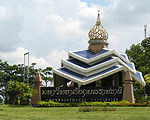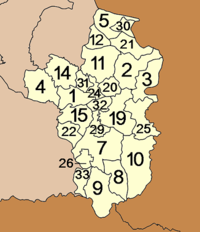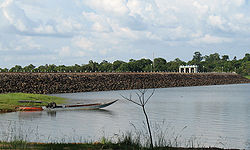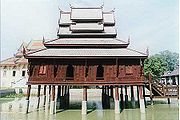
Ubon Ratchathani Province
Encyclopedia
History
The area was part of the Khmer EmpireKhmer Empire
The Khmer Empire was one of the most powerful empires in Southeast Asia. The empire, which grew out of the former kingdom of Chenla, at times ruled over and/or vassalized parts of modern-day Laos, Thailand, Vietnam, Burma, and Malaysia. Its greatest legacy is Angkor, the site of the capital city...
. Before the late eighteenth century, this area evidently was outside Siamese or Thai Ayutthaya Kingdom.
After the fall of Ayutthaya in 1767 several new tribes settled there, including the Kha and Suai. Siamese/ Thai began to expand its influence over the area since the rise of Thonburi and Bangkok Kingdoms. Twenty years later King Rama I offered a noble title to the local leader who could unite the many small settlements into one town. This was accomplished in 1786 with the founding of Ubon Ratchathani by Thao Khamphong, the Laotian prince who fled from Vientiane
Vientiane
-Geography:Vientiane is situated on a bend of the Mekong river, which forms the border with Thailand at this point.-Climate:Vientiane features a tropical wet and dry climate with a distinct monsoon season and a dry season. Vientiane’s dry season spans from November through March. April marks the...
. Ubon Ratchathani was then named as Bangkok's tributary subject.
Before it became a province. Ubon Ratchathani was the administrative center of the monthon
Monthon
A monthon |]], literally "circle") was a country subdivision of Thailand in the beginning of the 20th century. The Thai word 'monthon' is a translation of the word Mandala. These were created as a part of the thesaphiban bureaucratic administrative system, introduced by Prince Damrong Rajanubhab...
Isan, of which monthon Ubon was split off. In 1925 it became part of monthon Nakhon Ratchasima, with the abolishment of the monthon in 1933 the province became a first level subdivision of the country.
Until 1972 the Ubon Ratchathani province was the largest province of Thailand areawise. In 1972 Yasothon
Yasothon Province
Yasothon is one of the provinces of Thailand, located in the North-East of Thailand on the Chi River. Neighboring provinces are Mukdahan, Amnat Charoen, Ubon Ratchathani, Sisaket and Roi Et.-Geography:...
was split off, in 1993 Amnat Charoen
Amnat Charoen Province
Amnat Charoen is one of the north-eastern provinces of Thailand. Neighboring provinces are Ubon Ratchathani, Yasothon and Mukdahan. To the east it borders Salavan of Laos.-Geography:...
, after which it now holds the 5th rank.
Education

Ubon Ratchathani University
Ubon Ratchathani University was established as a campus of Khon Kaen University, Thailand, in 1987. It gained independent university status in 1990.-History :...
.
Symbols
The provincial seal shows a LotusNymphaeaceae
Nymphaeaceae is a family of flowering plants. Members of this family are commonly called water lilies and live in freshwater areas in temperate and tropical climates around the world. The family contains eight genera. There are about 70 species of water lilies around the world. The genus...
flower in a pond. This refers to the meaning of the name of the province, which translates to Royal city of the lotus flower. Therefore the provincial flower also is the Lotus (Nymphaea lotus
Nymphaea lotus
Nymphaea lotus, the Tiger Lotus, White lotus or Egyptian White Water-lily, is a flowering plant of the family Nymphaeaceae-Description:It grows in various parts of East Africa and Southeast Asia....
). The provincial tree is the Yang-khao (Dipterocarpus alatus
Dipterocarpus alatus
Dipterocarpus alatus is a tropical forest tree from Cambodia, Laos, Thailand and Viet Nam - where it is known as Dau nuoc . It often occurs gregariously along river banks and is a key planting species for regenerating deforested land around the Dong Nai river and Cat Tien National...
).
Administrative divisions

Amphoe
An amphoe is the second level administrative subdivision of Thailand. Usually translated as district, amphoe make up the provinces, and are analogous to a county seat...
). The districts are further subdivided into 219 subdistricts (tambon
Tambon
Tambon is a local government unit in Thailand. Below district and province , they form the third administrative subdivision level. As of the 2009 there are 7255 tambon, not including the 169 khwaeng of Bangkok, which are set at the same administrative level, thus every district contains 8-10 tambon...
) and 2469 villages (muban
Muban
Muban is the lowest administrative subdivision of Thailand. Usually translated as village, they are the subdivision of tambon. As of 2008, there are 74944 administrative villages in Thailand. As of the 1990 census, the average village consisted of 144 households or 746 persons.A muban does not...
). The numbers missing in the table are the districts which formed the province Amnat Charoen in 1993.
|
|
Municipalities
| Nr. | City/Town | Thai Thai alphabet Thai script , is used to write the Thai language and other, minority, languages in Thailand. It has forty-four consonants , fifteen vowel symbols that combine into at least twenty-eight vowel forms, and four tone marks .... |
Urban Population | Notes |
|---|---|---|---|---|
| 1. | Ubon Ratchathani Ubon Ratchathani Ubon Ratchathani is a city on the Mun River in the south-east of the Isan region of Thailand. It is known as Ubon for short. The name means "Royal Lotus City." The provincial seal features a pond with a lotus flower and leaves in a circular frame. Ubon is the administrative centre of Ubon... |
เทศบาลนครอุบลราชธานี | 85,557 Inh. | Capital of the province,Historic town,Touristical,International Airport |
| 2. | Warin Chamrap | เทศบาลเมืองวารินชำราบ | 30,521 Inh. | Educational, Railway Terminal |
| 3. | Phibun Mangsahan | เทศบาลเมืองพิบูลมังสาหาร | 11,326 Inh. | |
| 4. | Det Udom | เทศบาลเมืองเดชอุดม | 14,933 Inh. | |
| 5. | Kham Yai | เทศบาลตำบลขามใหญ่ | 54,679 Inh. | |
| 6. | Saen Suk | เทศบาลตำบลแสนสุข | 23,070 Inh. | |
| 7. | Trakan | เทศบาลตำบลตระการ | 7,672 Inh. | |
| 8. | Nam Yuen | เทศบาลตำบลน้ำยืน | 9,644 Inh. | |
| 9. | Pathum | เทศบาลตำบลปทุม | 10,679 Inh. | |
| 10. | Ubon | เทศบาลตำบลอุบล | 6,070 Inh. | |
| 11. | Huai Khayung | เทศบาลตำบลห้วยขะยูง | 3,64 6 Inh. |

Sights
Thung Si Mueang (ทุ่งศรีเมือง) - is a beautifully landscaped public park in the heart of the city in front of the city hall. It houses an imitation of a carved candle sculpture, health park, and playground.City Pillar Shrine (ศาลหลักเมือง) - Located at the southern corner of the field, the sacred pillar was built in 1972.
Monument of Phra Pathum Worarat Suriyawong or Chao Kham Phong (อนุสาวรีย์พระปทุมวรราชสุริยวงศ์ หรือ เจ้าคำผง) - Phra Pathum Worarat Suriyawong is the founder of Ubon Ratchathani during 1778-1795.
Sculpture of Somdet Phra Maha Wirawong or Tisso Uan (ปฏิมากรรมสมเด็จพระมหาวีรวงศ์ หรือ ติสโส อ้วน) - a famous monk who was well versed in Sutra and Vipassana.
Monument of Goodness (อนุสาวรีย์แห่งความดี) - The monument was built by WWII PoWs to honour the generosity and goodness of the people of Ubon Ratchathani.
Sculpture of Harmony and Progress (ปฏิมากรรมร่วมใจก้าวไปข้างหน้า) - The sculpture represents the harmony of 4 countries: Thailand, Lao PDR., Cambodia, and Vietnam.
Wat Thung Si Mueang (วัดทุ่งศรีเมือง) The Buddha’s footprint is housed in the Ubosot which mirrors art blending between the early Rattanakosin era and that of Vientiane. Another important building in the temple is the Ho Trai - the Hall of Tipitaka scriptures. The wooden hall was built in the pond to protect the Tipitaka from insects.
Wat Si Ubon Rattanaram or Wat Si Thong (วัดศรีอุบลรัตนาราม หรือ วัดศรีทอง) - The Ubosot houses a sacred Buddha image known as “Phra Kaeo Butsarakham”. The Buddha image, in the attitude of subduing Mara, is carved from topaz into the Chiang Saen style. Each year, in the Songkran Festival, people will parade the Buddha image around for the people to pay respect and bathe.
National Museum of Ubon Ratchathani (พิพิธภัณฑสถานแห่งชาติ อุบลราชธานี) - The single-storey hip roofed building, built in 1918, once served as the city hall before it was handed to the Fine Arts Department. The museum features local exhibitions: geography, history of the city’s establishment, archaeological fine art objects, local handicrafts and folk games.
The Golden Jubilee Art and Cultural Centre (ศูนย์ศิลปวัฒนธรรมกาญจนาภิเษก) - The 7-storey building in contemporary Isan architecture was built to commemorate the Golden Jubilee Celebrations of His Majesty’s Accession to the Throne. H.R.H. Princess Maha Chakri Sirindhorn presided over the opening ceremony on 11 December, 2001.

Wat Maha Wanaram (วัดมหาวนาราม) - It was at first only a ‘Samnak Song’, a monastic residence, for Vipassana monks. According to a stone inscription found behind the principal Buddha statue, Phrachao Yai In Paeng, it was built in 1807. The stucco Buddha statue, in the attitude of subduing Mara, was built in the Laotian style.
Wat Burapharam (วัดบูรพาราม) - The temple once served as a residence for famous meditation monks. Today, the temple houses life-like stone figures of these monks.
Wat Supattanaram Worawihan (วัดสุปัฏนารามวรวิหาร) - This is the first Dhammayutika temple of the province. The temple has a special Ubosot designed by a royal highway engineer Luang Sathit Nimankan (Chuan Supiyaphan). It has a Thai-style roof, western style hall and Khmer-style base.
Hat Wat Tai (หาดวัดใต้) - The beach situated in the middle of the Mun River. During the dry season, its white sandy beach is a favourite place for holiday-makers to enjoy the easy atmosphere and greenery.
Ban Kan Lueang Archaeological Site (แหล่งโบราณคดีบ้านก้านเหลือง) - It is an archaeological site which can be dated back to 2,800-2,500 years ago. In 1996, the Fine Arts Department found a number of artefacts such as beads, pottery, bronze bells, iron axes and chaff.
Wat Sa Prasan Suk or Wat Ban Na Mueang (วัดสระประสานสุข หรือ วัดบ้านนาเมือง) - The temple houses a special Ubosot in the shape of the Suphannahong Royal Barge decorated with mosaic. The abbot, Achan Bunmi, is widely honoured among the people of Ubon Ratchathani as well as those from nearby provinces.
Hat Khu Duea (หาดคูเดื่อ) - The beach by the Mun River is 12 km from downtown Ubon Ratchathani via Highway 24. Lots of restaurants on the raft are available.
Ban Pa-ao (บ้านปะอาว) - The ancient village is situated in Tambon Nong Khon. Since two centuries ago, the villagers actually immigrated from Vientiane during the reign of King Siri Bunsan and settled here. The village is famed for its brass work in an ancient style.
Wat Nong Pa Phong (วัดหนองป่าพง) - The temple is situated in a lush forest of Tambon Non Phueng. The tranquillity allows monks to study and practice Vipassana meditation. Attractions in the temple include the Phra Phothiyan Thera Museum that displays the eight requisites and wax model of Luangpu Cha.
Wat Pa Nana Chat (วัดป่านานาชาติ) - Numerous foreign monks study and practice Vipassana meditation here; most of them can speak Thai fluently and pray in Pali. Strict practices of the monks here make the temple quite honourable among Buddhists.
Wat Phukhao Kaeo (วัดภูเขาแก้ว) - The temple has a very beautiful Ubosot which is delicately decorated with a tiered roof covered with terracotta tiles and supporting a golden spire in the middle. Inside is the high-relief regarding important Phrathats, relic-containing pagodas, of Thailand.
Kaeng Saphue (แก่งสะพือ) - The rapids in the Mun River is a place to relax and enjoy the currents and wave sound. ‘Saphue’ derives from the word ‘Samphuet’ in Suai ethnic language which means large serpent.
Sirindhorn Dam (เขื่อนสิรินธร) - Called Khuean Dom Noi by the locals, the rockfill dam with a clay core was constructed across the Lam Dom Noi, a tributary of the Mun River. The hydroelectric dam is 42 metres high and 940 metres long.
Chong Mek (ช่องเม็ก) - The permanent Thai-Lao border pass is 90 km from downtown Ubon Ratchathani. The pass is a land bridge to Champasak Province.
Kaeng Tana National Park (อุทยานแห่งชาติแก่งตะนะ) - The park features plateaux and undulating hills with deciduous dipterocarp forest and grassland. The park has many attractions; namely,
Don Tana (ดอนตะนะ) - An island in the middle of the Mun River of only 450 metres wide and 700 metres long.
Kaeng Tana (แก่งตะนะ) - The largest rapids of the Mun River. In the middle of the rapids, there is a huge sandstone boulder splitting the river into two streams, and a concrete block built during the French Colonial Era to identify a channel for cruising.
Tham Phra or Tham Phu Ma Nai (ถ้ำพระหรือถ้ำภูหมาไน) - A stone inscription and Lingam base or ‘Yoni’ from the 7th-8th Century were found. Now the original stone inscription is kept in the National Museum, Ubon Ratchathani.
Namtok Rak Sai Nature Trail (เส้นทางศึกษาธรรมชาติน้ำตกรากไทร) - The trail lines the cliff by the Mun River, 500 metres from the park’s headquarters. It runs by the cliff for 1 km. through various kinds of flora, such as lichen, moss, and fern, Tham Phra and Namtok Rak Sai.
Namtok Tat Ton (น้ำตกตาดโตน) - The waterfall is situated on Highway 2173, off Highway 217 by 5 km.
Annamese Lion Pulpit at Ban Chi Thuan (ธรรมาสน์สิงห์ศิลปะญวนที่บ้านชีทวน) - The Buddhist pulpit is placed at Wat Sinuan Saeng Sawang Arom. The concrete pulpit itself is quite unique with a lion sculpture carrying the pulpit with decorative stucco, multi-layer wooden roof, and painting in the Annamese style.
Wat Thung Si Wilai (วัดทุ่งศรีวิไล) - The temple houses Luangpho Wiset, the principal Buddha image carved from laterite seated beneath the Naga’s hood. The sacred Buddha image from the Dvaravati period is considered a sacred icon for the village. The temple is surrounded by several enclosures of Sima stones that mark the temple’s consecrated boundary.
Wat Tham Kuha Sawan (วัดถ้ำคูหาสวรรค์) - The temple was built by Luangpu Khamkhaning Chulamani to be a place for meditation practice where he also resided. Today, Luangpu has died but his body, which is not rotten, is well kept in a glass coffin and considered a sacred item.
Maenam Song Si (แม่น้ำสองสี) - At the mouth of the Mun River, Ban Woen Buek. The Mun River runs into the Mekong, so we can see two rivers, in two different colours – ‘Song Si’ means two colours - blending together. The Mekong River will be reddish brown while the Mun River is rather blue.
Pha Taem National Park (อุทยานแห่งชาติผาแต้ม) - The park features plateaux, undulating hills, and towering cliffs with strange sandstone formations scattered around. The park is covered mostly by deciduous dipterocarp forest and wild flowers can be found on the rock terrace. Its attractions include:
Sao Chaliang (เสาเฉลียง) - Carved by wind and water for millions of years, the mushroom-like stone towers are scattered around the area containing shell fossils, sand and gravels in their texture. Geologists assumed that over million years ago this area was once a sea.
Pha Taem and Pha Kham (ผาแต้มและผาขาม) - The towering cliffs house groups of pre-historical paintings which date back to 4,000-3,000 years ago. There are over 300 paintings in five categories including animals, geometrical motifs, rice farmers, hands, and ‘Tum’ or typical fish trap.
Namtok Soi Sawan (น้ำตกสร้อยสวรรค์) - Two streams, Huai Soi and Huai Phai, combine and plunge 20 metres down to the pond below, making the waterfall look like a necklace – ‘Soi’ in Thai.
Namtok Thung Na Mueang (น้ำตกทุ่งนาเมือง) - The medium-sized waterfall cascades down a 25-metre cliff through flowerbeds which are in full bloom between October to December.
Namtok Saeng Chan or Namtok Ru (น้ำตกแสงจันทร์หรือ น้ำตกรู) - The tiny fall is special as the stream falls through a hole – ‘Ru’ – down to the pond below. At noon, sunshine through the hole makes the waterfall look like a ray of moonshine – ‘Saeng Chan’.
Dong Na Tham Forest (ป่าดงนาทาม) - From September to November is the best time to enjoy the nature around while flowers are in full bloom, as well as waterfalls and fogs over the Mekong River. From January to March is the best time to see the forest change its hue, with trees shedding their leaves, and to cruise in the Mekong from Ban Pak La to Khan Tha Kwian.
Wat Phu Anon (วัดภูอานนท์) - The temple has interesting attractions including a rock terrace with large footprints, nature-made stone jar, and cave painting.
Phu Lon (ภูหล่น) - The mountain is in Tambon Song Yang, 20 km north of Amphoe Si Mueang Mai. It has a cave where the late famous monk Phra Achan Man Phurithatto practiced his Vipassana.
Namtok Huai Sai Yai or Kaeng I Khiao (น้ำตกห้วยทรายใหญ่ หรือ แก่งอีเขียว) - The waterfall is in the Buntharik - Khao Yot Mon Wildlife Sanctuary. The waterfall runs over the rock terrace among a shady environment.
Phu Chong - Na Yoi National Park (อุทยานแห่งชาติภูจอง-นายอย) - The park covers a total area of 686 km2. Its boundary connects to Lao PDR and Cambodia in the area called the Emerald Triangle. Its attractions include.
Namtok Huai Luang or Namtok Bak Teo (น้ำตกห้วยหลวง หรือ น้ำตกบักเตว) - Plunging down three steps from an elevation of 30 metres, the waterfall has a small pool with a white beach and turquoise coloured water.
Phlan Yao Rock Garden (สวนหินพลานยาว) - Rocks in different formations are scattered around the area.
Pha Phueng Viewpoint (จุดชมทิวทัศน์ผาผึ้ง) - The viewpoint is just next to the rock garden.
Namtok Koeng Mae Phong (น้ำตกเกิ้งแม่พอง) - The waterfall is 9 km south of Namtok Huai Luang along the nature trail. It originates from the Lam Dom Noi Stream.
Kaeng Sila Thip (แก่งศิลาทิพย์) - Huai Luang Stream runs over a rock terrace and turns fierce in the rapids. In the middle of the stream, stream power has created lots of holes on the rock surface in different sizes and depths called “Kumphalak.”
Phlan Kong Kwian (พลาญกงเกวียน) - The vast rock terrace with rock shelters at the front is home to wild flowers and plants. In previous days, travellers could seek shelter from this place. Thus, it is called Phlan Kong Kwian which literally means cart terrace.
Phu Hin Dang (ภูหินด่าง) - The cliff-top viewpoint to witness the forest scenery of Lao PDR. and Cambodia. Its cliff is especially painted with natural bright hues. Geologists explain that dry weather millions of years ago catalyzed the mineral residues in the seawater and resulted this way.
Namtok Kaeng Lamduan (น้ำตกแก่งลำดวน) - The fall is situated in the compound of the Ubon Ratchathani Wildlife Reservation Promotion and Development Station. The waterfall runs over a rock terrace and through the shady forest of Lamduan trees.
Prasat Ban Ben (ปราสาทบ้านเบญจ์) - The Khmer sanctuary is a religious site comprising three brick Prangs on separated laterite bases. The Fine Arts Department excavated the site in 1990 and found lintels featuring 9 directional guardian angels and the God Indra on his Erawan heavenly elephant.
Local products
Ubon Ratchathani’s local products include hand-woven cotton, KhitKhit
Khit, or Khid, is an ancient type of woven cloth produced in certain areas of Isaan, the northeastern region of Thailand.-Tradition:Khit weaving is done by hand in traditional looms. It favours certain basic colors, like red, purple and dark green, although other colors are also used...
pillow, loincloth, silk, brassware, and basketry.
Mu Yo (Moo Yaw) or preserved pork, Chinese sausage, Isan sausage, and Khem Mak Nat or black-eared catfish or iridescent shark-catfish in saline water with chopped pineapple. Various preserved and ready-to-eat food such as dried fish, dried frog’s skin, and steamed bun with bamboo shoot stuff.
Festivals
Flower Festival (งานเทศกาลไม้ดอกไม้ประดับ) - Held every February at Thung Kham Nam Saep Stadium, Amphoe Warin Chamrap, the festival features floral floats, decorative and flowering plant contests and fair.Kaeng Saphue Songkran Festival (งานประเพณีมหาสงกรานต์แก่งสะพือ) - Held every April in Amphoe Phibun Mangsahan, the festival comprises a beauty contest, fair, local sports, and local music contest.
Illuminated Boat Procession (งานประเพณีไหลเรือไฟ) - Held every October to mark the end of the Buddhist Lent, boats from different temples will illuminate the river near the Rattanakosin Bicentennial Bridge.
Traditional Boat Races (งานแข่งขันเรือยาวประเพณี) - Several boat racing tournaments are held annually in October after the end of the Buddhist Lent. The Mueang Ubon Ratchathani Municipality’s tournament is held near the Rattanakosin Bicentennial Bridge. Tambon Phibun Mangsahan Municipality’s tournament is held near the Mun River Bridge, and Wat Pho Tak’s tournament is held in front of the temple.
External links
- Website of province (Thai only)

